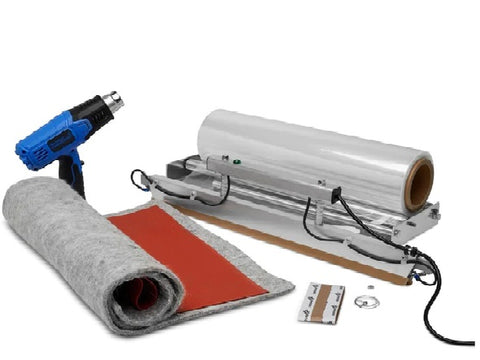The Issues of Eco-Friendly Packaging in the Cosmetic Industry
It’s very difficult to be 100% eco-friendly whilst maintaining product standards and as small businesses we will need to compromise. However, just because we use a certain product now, doesn’t mean there won’t be better alternatives in the future. If we keep asking the manufacturers of these things for better options then eventually the demand will mean change.
There are already 100% compostable shrink film options, but the manufacturers supply only to large factories and not individual rolls for retail. This is sad, as many small businesses would benefit from these options. I urge you, if you find any, to bring this to their attention, as the more they are requested on a smaller scale, the more likely they are then to become available. Current minimum orders are around a ton, which is obviously both too expensive and too cumbersome to store for a small business.
It’s often the small businesses who are the most concerned about their environmental impact and do the most to improve this side of their business, but they also get the most ‘flack’ from customers. It’s unreasonable to expect a small business to be 100% eco-friendly as it’s as an expensive obligation right now, and it’s even more unreasonable to expect them not to do their job because they need to use a bit of plastic.
We can all do better in our daily lives, so let’s stop judging one another and all do the best we can.
Consider what you do in your own life before tearing into a small business about using a bit of plastic packaging. There are many day-to-day activities and items that cause significant environmental impact. Here are some examples:
- Transportation: Cars, trucks, buses, and airplanes emit greenhouse gases and pollutants that contribute to air pollution and climate change.
- Single-use plastic: Disposable plastic items such as straws, water bottles, and food packaging are major sources of plastic waste that end up in landfills and oceans.
- Energy consumption: Fossil fuel-based energy sources such as coal, oil, and gas contribute to greenhouse gas emissions and climate change.
- Food choices: The production of meat, particularly beef, requires significant amounts of water, land, and energy, and contributes to deforestation and greenhouse gas emissions.
- Water use: Excessive water use, particularly in areas with limited water resources, can lead to water scarcity and ecosystem degradation.
- Electronics: The production and disposal of electronic devices such as smartphones, computers, and televisions contribute to the release of toxic chemicals and e-waste.
- Clothing: The textile industry is a significant source of pollution and greenhouse gas emissions, particularly in the production of synthetic fabrics.
- Household waste: The disposal of household waste, particularly non-biodegradable items, contributes to landfill pollution and greenhouse gas emissions from decomposition.
- Paper products: The production and disposal of paper products contribute to deforestation, greenhouse gas emissions, and landfill pollution.
- Having children. Every child will have a carbon footprint and affect all of the above, though I’m not telling you not to have children, obviously, but it is true.
Controversy surrounding Biolefin (oxo biodegradable shrink wrap) and why I’m even bothering with shrink wrap.
What is Biolefin (oxo biodegradable shrink wrap)?
To explain, it is easier to quote The National Shrink Wrap Company directly:
‘Biolefin™ Oxo-Biodegradable Polyolefin Is A Standard Polyolefin To Which Mineral Salt Additives Have Been Included, Rendering The Film Capable Of Absorbing Water. Once Discarded Properly, It Ends Up In A Landfill, Where, When Exposed To Light, Wind, Water, Heat, And The Native Microbial Organisms Found In A Landfill, The Water-Enriched Film Is Capable Of Being Assimilated By Those Micro-Organisms, Which Then Excrete It As Biomass, With No Discernable Plastic Particulate.
So, What Begins As A Chemical Process, With The Mineral Salts Enabling The Film To Absorb Moisture, Ends As A Biological Process, As The Microorganisms Consume And Convert The Film To Biomass.
New & Faster Acting! The Latest Version Of The Film (Biolefin™ 2.0) Has Been Tweaked To Degrade In 2-3 Years After Discard. The Biodegradation Process Begins After Suitable Discard In A Landfill And Completes In 2-3 Years. Biolefin™ Will Not Degrade On Products Sitting On Shelves!’
This company make an excellent system for both the Polyolefin and Biolefin based shrink wraps. It comes with the stand, matt, heated cutting tool and heat gun. All excellent quality and I highly recommend as their customer service is also very good. So, I’ll say now, I have nothing whatsoever against this company, they are trying to make a positive difference just like the rest of us.

Image credit: National Shrinkwrap company
So here are my points for consideration as to whether I want to, or indeed am allowed to, use Biolefin in the UK for my products and why I’d want to use Shrink wrap in my business at all.
- Biolefin is only easily available from Canada (from what I’ve found) and the fact I’d have to ship it overseas to use, somewhat increases its environmental impact rather than reducing it, though this will depend on the amount I use verses the emissions and offsetting that with eco-cart and similar. Plus, does it still make more sense than using normal shrink wrap?
- OXO- biodegradable plastics are being debated for banning in the UK, as although they do degrade over 2-3 years, it’s been debated that they may degrade into micro plastics which have a huge negative impact on the environment, though the manufacturers state this is definitely not the case, and ECHA have been able to produce no evidence of microplastics. The debate is ongoing and more information can be found here https://commonslibrary.parliament.uk/single-use-plastic-how-do-bans-differ-across-the-uk-and-eu/
- Although ideally, I’d use no plastic at all, realistically for a business such as mine, shrink wrap makes the most sense for a few of my products. By using shrink wrap I provide a hygienic seal for my products, which let’s face it, will be picked up and smelt a lot at markets. Shrink wrap helps to maintain the products shelf life, protects a product during transit to customers and helps prevent scent loss. Because of these things, less products go to waste due to breakages in shipping, being unhygienically handled at markets or simply just passing their best on the shelf due to being open to the air.
- I could choose to use a shrink film made from 30% repurposed recycled materials that can also widely be recycled along with your plastic bags at local waste management services and most bag recycling bins, is this better?
- I am partnered with eco cart who allow customers to offset the carbon footprint of their order by paying a small proportionate donation at checkout that goes towards environmental causes around the world like planting trees and building eco-friendly infrastructure.
- Is paper, or cardboard actually any better? Given the energy and resources required to recycle it? And the trees required to make it? By moving so definitively to one resource from another, because we are told its better can create problems with that too. Can we plant trees as fast or faster than we are consuming them? Also, although cardboard is a renewable source it has a much higher carbon footprint and actually contributes far more to greenhouse gases than plastic. It takes far more energy to make carboard than it does plastic. So, it’s kind of like swapping one environmental issue for another. There is also the printed box issue, whereby the box may be coated in a non-recyclable material or printed in non-eco-friendly ink.
The only real solution is for people to stop consuming entirely, which is unlikely to happen, so we all make the best choices that we can.
Packaging laws in the EU.
Further to this topic, you may or may not be aware of the packaging laws in some EU countries. If sending products to certain countries, such as Germany, France and Spain, you need to comply with their specific packaging directives and there are fees to pay if you send (very) large amounts, to contribute to their recycling costs. For more information on this see these websites:
https://www.ecosistant.eu/en/packaging-law-spain/
https://www.clarity.eu.com/plastic-packaging-tax-the-complete-guide/
The positive take away from all of this, is that the world is now more aware than ever of the impact of its actions on the environment. New products are manufactured with consideration to their environmental impact and new innovative solutions are being worked on all the time. Until then, put pressure on the manufacturers of packaging to provide sustainable, eco friendly options. Don’t shun small businesses for using what they use. Sometimes it is the only suitable for option for them. They are trying their best, and who knows their environmental impact may still be much lower than your own!




Leave a comment